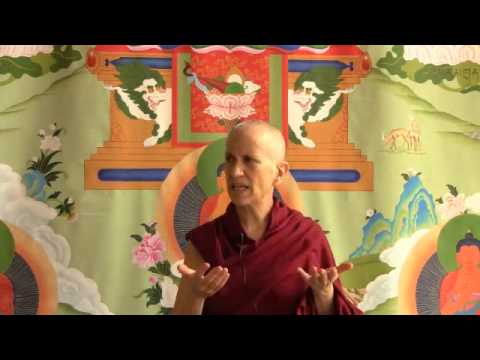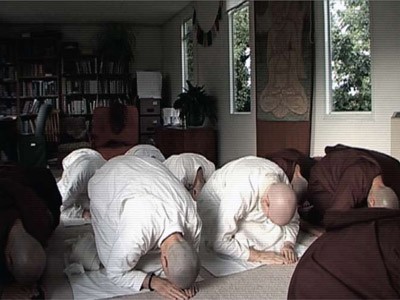The pratimoksha vows
Stages of the Path #120: The Fourth Noble Truth
Part of a series of Bodhisattva's Breakfast Corner talks on the Stages of the Path (or Lamrim) as described in the Guru Puja text by Panchen Lama I Lobsang Chokyi Gyaltsen.
When doing the higher training in ethical conduct, the basis is abandoning the ten nonvirtues and keeping the ten virtues. But it specifically applies to keeping the pratimoksha vows, or the vows of individual liberation. That’s when we’re talking about the higher training of ethical conduct in terms of just the general path that’s applying to the hearers, the solitary realizers, and the bodhisattvas. The bodhisattva vow is a different type of ordination. The tantric vow is a different type of ordination than the pratimoksha vows. We always start with the pratimoksha vows. Then the bodhisattva vows are for the people who, in addition to seeking liberation, are seeking enlightenment and they want that vow. And the tantric vows are specifically for the people involved in the tantric vehicle. But they all depend on the pratimoksha.
Within the pratimoksha there are eight kinds of vows. Each vow has numerous precepts. I think it’s better to say it like this. It’s the five lay precepts and it’s the lay vow, which has five lay precepts. Otherwise, like I was explaining the other day, if we say five vows then we import our Catholic meaning of “vow” in, which is that it comes from outside—not necessarily Catholic, but theistic view—it comes from God and you get punished. It comes from outside and it’s not your choice. Whereas all of these, the “vow” is basically the promise that you’re making, and then the precepts are the individual trainings that you’re taking on as a result of making that promise.
The eight vows in the pratimoksha vow are eight different ordinations.
You have the one-day vow (1) in which there are eight precepts. This is not to be mixed up with the Mahayana eight precepts, because the pratimoksha vow is taken with the motivation to attain liberation, and the eight Mahayana precepts are taken with the bodhicitta motivation. But in terms of the precepts themselves they’re very similar. That’s one.
Then you have the male (2) and female (3) lay practitioners and they keep five precepts.
Then you have the male (4) and female (5) shramanera/shramanerika (or novices) and they keep ten precepts. In the Tibetan tradition it’s broken up into 36 precepts. I’ve been trying to find out the source of that, who did that, where that came from. I haven’t been able to find that.
The nuns have another ordination (6) called the shikshamana, or dge slob ma, and that is a two-year probation period.
Then you have the bhikshu (7) and bhikshuni (8), the male and female fully ordained people.
Those eight (the one-day, the two lay, the two novices, the intermediate nun, and the fully ordained two), those eight are the different kinds of pratimoksha vows.
If you want to take the full ordination, then you have to take the novice, you have to take the five precepts. They’re built one upon the other.
Audience: Can you take the one-day vows before having taken the lay precepts?
Venerable Thubten Chodron (VTC): Can you take the one-day vows before having taken the lay precepts? I believe you can. In general you should have refuge to do any of the eight. I know at the Kopan courses they got special permission from–I don’t know, Trijang Rinpoche or somebody, one of Lama and Rinpoche’s teachers–so that the people who attended the month-long Kopan course could take the eight Mayahana precepts without having taken refuge first.
Audience: Where do the anagarika vows fit in?
VTC: The anagarika vows are actually a type of lay precept. You’re still technically an upasika or upasaka. Usually what we call an anagarika is somebody who has taken the eight one-day precepts for a long period of time. Put it that way. Rather than taking them each morning you just say “I’m going to take it for a year, I’m going to take them for the rest of my life” whatever, something like that. So we call that anagarika. The Tibetans call it “gomi genyen” which is an upasika/upasaka who has the eight precepts with celibacy.
Also, in the Tibetan tradition they have something called “rabjung” which means “going forth.” This is the ordination that they give to the little monks when they’re like five, six, seven, eight, nine years old, where they can wear robes, they keep the five precepts, including celibacy, and they keep three trainings which are to abandon wearing lay clothes, to wear robes, and to follow their preceptor. And “wear robes” can be confusing in the Tibetan tradition. Because you can take the eight precepts for life and not wear robes, and be a householder, and I think that’s the best way to do it. Or do it like we do in the Abbey, you wear gray and it’s part of your training for ordination. But you can take the eight without training for ordination. Although sometimes they will give you permission, if you take the eight anagarika vows, to wear robes. The Tibetan’s will often do that. It can be confusing because the people aren’t actual monastics but they’re given that permission.
Then sometimes instead of giving them the eight anagarika they give them the rabjung where they have the five lay precepts but they’ve “gone forth” in that they have abandoned wearing lay clothes, wear robes, and follow their preceptor. So sometimes people say, “Well I took rabjung” (because they weren’t ready to become a shramanera/shramanerika) And they say “I took eight precepts.” And then you ask them which eight, and sometimes they aren’t clear. So if you’re in that category you need to be very clear what you’re taking. Because often people go in, the ceremony’s in Tibetan, they’re not quite sure, there are eight somethings. And they aren’t sure whether it’s rabjung or whether it’s the gomi genyen with the eight precepts. Because they don’t even know that there are these different things. So, there can sometimes be confusion.
Venerable Thubten Chodron
Venerable Chodron emphasizes the practical application of Buddha’s teachings in our daily lives and is especially skilled at explaining them in ways easily understood and practiced by Westerners. She is well known for her warm, humorous, and lucid teachings. She was ordained as a Buddhist nun in 1977 by Kyabje Ling Rinpoche in Dharamsala, India, and in 1986 she received bhikshuni (full) ordination in Taiwan. Read her full bio.


